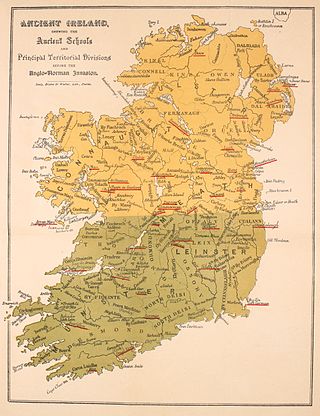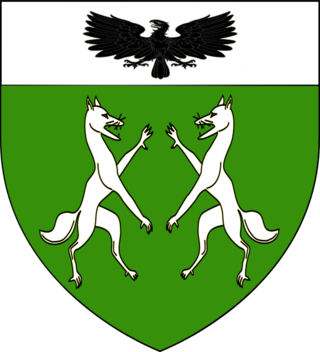Ailill Ollamh (or Oilill Olum) in Irish traditional history was the son of Mug Nuadat and was a king of the southern half of Ireland, placed in the 3rd century by early modern Irish genealogy. Sadb ingen Chuinn, daughter of Conn of the Hundred Battles, in her second marriage, married Ailill. He divided the kingdom between his sons Éogan Mór, Cormac Cas, and Cían. Éogan founded the dynasty of the Eóganachta. Sadb's son Lugaid Mac Con, who was Ailill's foster-son, became High King of Ireland.
The Book of Leinster contains poems ascribed to him.
Several Irish surnames claim descent from Ailill Ollamh, reflecting a common tradition in Irish genealogy where families trace their lineage back to notable figures in mythology and history. An Leabhar Muimhneach (The Book of Munster) has an extensive genealogy of the Eóganacht septs.
In one of the oldest surviving tracts on the early history of the Deirgtine, the Proto-Eóganachta, Ailill is himself called a druid. [1] Furthermore, whether or not his father Mug Nuadat ever existed beyond some family association with the god Nuada, Ailill is usually believed a relation or probable descendant of Nia Segamain.
Conn Cétchathach, or Conn of the Hundred Battles, son of Fedlimid Rechtmar, was a legendary High King of Ireland who is claimed to be the ancestor of the Connachta, and through his descendant Niall Noígiallach, the Uí Néill dynasties, which dominated Ireland in the early Middle Ages.
Mongfind is a figure from Irish legend. She is said to have been the wife, of apparent Munster origins, of the legendary High King Eochaid Mugmedón and mother of his eldest three sons, Brión, Ailill and Fiachrae, ancestors of the historical Connachta. She was Eochaid's first wife; his second wife, Cairenn, gave birth to Niall of the Nine Hostages. Several tales depict Mongfind as an adversary of Niall. Mongfind is also said to have been the sister of Crimthann mac Fidaig, King of Munster and the next High King of Ireland, whom she is said to have killed with poison in a bid to make her son king. She drank the poisoned drink to convince Crimthann, and died soon after at Samhain.
The Cath Maige Mucrama is an early Middle Irish language tale which forms part of the Cycles of the Kings.
Lugaid Mac Con, often known simply as Mac Con, was, according to medieval Irish legend and historical tradition, a High King of Ireland. He belonged to the Corcu Loígde, and thus to the Dáirine. His father was Macnia mac Lugdach, and his mother was Sadb ingen Chuinn, daughter of the former High King Conn Cétchathach. Mac Con may be to some extent identical with another legendary King of Tara from the Dáirine, Lugaid Loígde.
In Irish mythological history Mug Nuadat son of Mug Neit, son of Derg, son of Dergthene, son of Enna Munchain, son of Loch Mor, son of Muiredach Mucna, son of Eochaid Garb, son of Dui Dalta Dedad was a legendary, supposed King of Munster in the 2nd century AD. He was, according to later medieval tradition, a rival of the High King, Conn of the Hundred Battles, and for a time after the year 123 was the de facto ruler of the southern half of Ireland. Everything south of a line drawn between Galway Bay and Dublin was known as Leth Moga, and everything north of that line was Leth Cuinn.
In Irish traditional history Eógan, eldest son of Ailill Ollamh, was a 2nd or 3rd century AD king of Munster. He ruled for either fifteen or seventeen years, though fifteen is the number most often given. He is credited with founding or at least giving his name to the Eóganachta, a dynasty which ruled as kings of Munster and later princes of Desmond until the late 16th century. He died at the battle of Maige Mucrama at the hands of his stepbrother, Lugaid Mac Con, which story is told in the Cath Maige Mucrama. The son of Eógan Mór was Fiachu Muillethan. His mother was Sadb ingen Chuinn, daughter of Conn of the Hundred Battles.

The Eóganachta were an Irish dynasty centred on Cashel which dominated southern Ireland from the 6/7th to the 10th centuries, and following that, in a restricted form, the Kingdom of Desmond, and its offshoot Carbery, to the late 16th century. By tradition the dynasty was founded by Conall Corc but named after his ancestor Éogan, the firstborn son of the semi-mythological 3rd-century king Ailill Aulom. This dynastic clan-name, for it was never in any sense a 'surname,' should more accurately be restricted to those branches of the royal house which descended from Conall Corc, who established Cashel as his royal seat in the late 5th century.
Crimthann Mór, son of Fidach, also written Crimthand Mór, was a semi-mythological king of Munster and High King of Ireland of the 4th century. He gained territory in Britain and Gaul, but died poisoned by his sister Mongfind. It is possible that he was also recognized as king of Scotland. This Crimthann is to be distinguished from two previous High Kings of Ireland of the same name, two Kings of Leinster, and another King of Munster, among others. Importantly, he is included in the Baile Chuinn Chétchathaig (summary), and is thus the last High King of Ireland from Munster until Brian Bóruma, over six hundred years later.

Leath Cuinn and Leath Moga are legendary ancient divisions of Ireland, respectively north and south of a line corresponding to the Esker Riada running east–west from Dublin Bay to Galway Bay. The eponymous Conn and Mug were Conn Cétchathach and Éogan Mór Mug Nuadat, whose armies in 123 AD fought the battle of Mag Lena.

Colmán of Cloyne, also Colmán mac Léníne, was a monk, founder and patron of Cluain Uama, now Cloyne, County Cork, Ireland, and one of the earliest known Irish poets to write in the vernacular.
Éogan is an early Irish male given name, which also has the hypocoristic and diminutive forms Eoganán, Eóghainin, Eóghain and Eóghainn. The Modern Irish form of the name is Eoghan.

The O'Donoghue of the Glens, Prince of Glenflesk, is the hereditary chieftain of his sept of the Kerry Eóganacht, Munster, Ireland. In 1944, his father was one of the few Chiefs of the Name recognized by Edward MacLysaght, the first Chief Herald, as having a verifiable pedigree and entitled to use the title and receive courtesy recognition by the Irish State.
Corc mac Luigthig (340-379), also called Conall Corc, Corc of Cashel, and Corc mac Láire, is the hero of Irish language tales which form part of the origin legend of the Eóganachta, a group of kindreds which traced their descent from Conall Corc and took their name from his ancestor Éogan Mór. The early kindred they belonged to are known as the Deirgtine. He was probably a grandson of Ailill Flann Bec, and possible cousins were Dáire Cerbba and the famous Crimthann mac Fidaig. The latter is his opponent in a celebrated cycle of stories.

The Kingdom of Munster was a kingdom of Gaelic Ireland which existed in the south-west of the island from at least the 1st century BC until 1118. According to traditional Irish history found in the Annals of the Four Masters, the kingdom originated as the territory of the Clanna Dedad, an Érainn tribe of Irish Gaels. Some of the early kings were prominent in the Red Branch Cycle such as Cú Roí and Conaire Mór. For a few centuries they were competitors for the High Kingship of Ireland, but ultimately lost out to the Connachta, descendants of Conn Cétchathach. The kingdom had different borders and internal divisions at different times during its history.

Dáire Cerbba was a 4th-century Irish dynast who was evidently a king of late prehistoric central northern Munster, called Medón Mairtíne at the time. A frequently believed grandson of his, Crimthann mac Fidaig, was High King of Ireland and some British territories, and another descendant Bressal mac Ailello may have been King of Munster, and whose sister Angias was Queen of Lóegaire mac Néill, High King of Ireland. Finally, another descendant, according to Geoffrey Keating, was a king of Munster named Cormac, son of Ailill, son of Eochaid, son of Dáire Cearb.
The Deirgtine, Clanna Dergthened or "Descendants of Dego Dergthened" were the proto-historical ancestors of the historical Eóganachta dynasties of Munster. Their origins are unclear but they may have been of fairly recent Gaulish derivation. Some evidence exists for their having been active in Roman Britain.
Fiachu Muillethan or Fiachu Fer Da Liach, son of Éogan Mór, was a legendary king belonging to the Deirgtine, the proto-historical ancestors of the Eóganachta dynasties of Munster. He is known primarily from the saga Forbhais Droma Dámhgháire, in which he is assisted by the famous Mug Ruith, who repels an invasion of his kingdom by Cormac mac Airt. The sons of Fiachu Muillethan were Ailill Flann Mór and Ailill Flann Bec.
Deda mac Sin was a prehistoric king of the Érainn of Ireland, possibly of the 1st century BC. Variant forms or spellings include Ded, Dedu, Dedad, Degad, Dega, Dego, Deguth and Daig, with some of these occurring as genitives although usage is entirely unsystematic, besides the rare occurrence of the obvious genitive Dedaid.
Sadb ingen Chuinn was a daughter of Conn of the Hundred Battles, a High King of Ireland. She married firstly Macnia mac Lugdach, prince of the Dáirine or Corcu Loígde, and was mother of Lugaid Mac Con, High King of Ireland. Upon the death of Macnia, she married secondly Ailill Aulom, king of southern Ireland, and was mother of Éogan Mór, ancestor of the Eóganachta. Her brother was Art mac Cuinn, also a High King of Ireland, while her sister Sáruit married Conaire Cóem of the Érainn, who was High King before him.